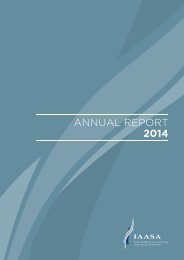Annual_Report2014
You also want an ePaper? Increase the reach of your titles
YUMPU automatically turns print PDFs into web optimized ePapers that Google loves.
<strong>Annual</strong> Report 2014<br />
15<br />
Examination of issuers’ financial reports<br />
IAASA concluded that additional and<br />
disaggregated forbearance disclosures were<br />
required in future annual financial statements of<br />
each of the financial institutions together with<br />
relevant qualitative disclosures.<br />
Following correspondence, each of the financial<br />
institutions examined undertook to provide<br />
additional forbearance disclosures in future<br />
financial statements.<br />
Correspondence with two institutions had<br />
concluded by 31 December 2014 and while<br />
correspondence with the third institution was<br />
on-going at year end it concluded prior to the<br />
publication of its 2014 financial statements.<br />
4.2. Accounting for uncertain tax positions<br />
Financial reporting requirements<br />
Liabilities for uncertain tax positions (‘UTPs’)<br />
arise where the ultimate tax treatment of an<br />
item is unclear or is a matter of dispute between<br />
an entity and the relevant tax authority. UTPs<br />
generally occur where there is an uncertainty as<br />
to the meaning of the law, or to the applicability<br />
of the law to a particular transaction, or both. The<br />
outcomes of UTPs are often open to different<br />
interpretation of local tax laws and may be<br />
resolved only over an extended period of time.<br />
IAS 12 Income Taxes applies to all taxes which are<br />
based on taxable profits. Paragraph 46 of IAS 12<br />
states that current tax liabilities (or current tax<br />
assets) for the current and prior periods shall be<br />
measured at the amount expected to be paid<br />
to (or recovered from) the taxation authorities,<br />
using the tax rates and tax laws that have been<br />
enacted or substantively enacted by the end of<br />
the reporting period.<br />
Paragraph 122 of IAS 1 Presentation of Financial<br />
Statements requires an entity to disclose the<br />
judgements that management has made in the<br />
process of applying the entity’s accounting<br />
policies and that have the most significant effect<br />
on the amounts recognised in the financial<br />
statements.<br />
Findings<br />
IAASA has examined the recognition,<br />
measurement and disclosures related to UTPs by a<br />
number of entities.<br />
IAS 12 lacks clarity with regard to the<br />
measurement of UTPs and as a result, a variety<br />
of methodologies are applied by issuers. In its<br />
examinations, IAASA detected that the recognition<br />
of a significant amount of UTP liabilities in issuers’<br />
financial reports were not matched with similar<br />
amounts of cash tax payments in later years.<br />
As a result of its engagement with issuers and the<br />
lack of clarity in IAS 12, IAASA raised the question<br />
of the measurement of UTPs with representatives<br />
of the IASB and IFRS Interpretations Committee<br />
(‘IFRS-IC’). As a result, the IFRS-IC discussed the<br />
measurement of assets and liabilities on UTPs at its<br />
meeting of 16 – 17 September 2014 3 . The IFRS-IC<br />
tentatively decided to proceed with the project on<br />
measurement of UTPs, subject to further analysis<br />
and deliberations. IFRS-IC also concluded that an<br />
entity should assume that the tax authorities will<br />
examine the amounts reported to them and have<br />
full knowledge of all relevant information (i.e. it<br />
should assume a 100% detection risk).<br />
Subject to the IFRS-IC’s deliberations on this<br />
matter, it is IAASA’s conclusion that an excessively<br />
prudent or conservative estimate/measurement of<br />
UTPs may be inconsistent with a fair presentation<br />
or the amount ‘expected to be paid’ to/recovered<br />
from the tax authorities.<br />
IAASA found that the disclosure of UTP<br />
measurement policies, key judgements and any<br />
changes therein has been varied and lacking in<br />
detail. As a result of examinations, a number of<br />
issuers have provided undertakings to improve<br />
their disclosure of the financial reporting<br />
treatments applied in respect of UTPs.<br />
It remains IAASA’s expectation that issuers’<br />
disclosures of their UTP measurement policies<br />
will be such that the key UTP measurement<br />
judgements are readily apparent to users of<br />
financial statements.<br />
3<br />
See http://media.ifrs.org/2014/IFRIC/September/IFRIC-Update-September-2014.pdf



